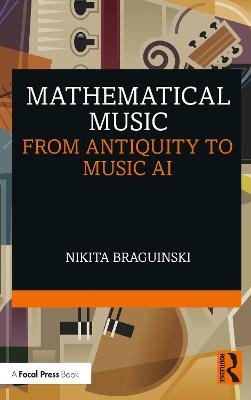
Mathematical Music
Focal Press (Verlag)
978-1-032-06219-8 (ISBN)
Mathematical Music offers a concise and easily accessible history of how mathematics was used to create music. The story presented in this short, engaging volume ranges from ratios in antiquity to random combinations in the 17th century, 20th-century statistics, and contemporary artificial intelligence.
This book provides a fascinating panorama of the gradual mechanization of thought processes involved in the creation of music. How did Baroque authors envision a composition system based on combinatorics? What was it like to create musical algorithms at the beginning of the 20th century, before the computer became a reality? And how does this all explain today’s use of artificial intelligence and machine learning in music? In addition to discussing the history and the present state of mathematical music, Braguinski also takes a look at what possibilities the near future of music AI might hold for listeners, musicians, and the society.
Grounded in research findings from musicology and the history of technology, and written for the non-specialist general audience, this book helps both student and professional readers to make sense of today’s music AI by situating it in a continuous historical context.
Nikita Braguinski is a musicologist and historian of technology. He studied musicology at the University of Cologne and wrote his PhD in media theory at the Humboldt University of Berlin. He was a visiting postdoctoral fellow at the Max Planck Institute for the History of Science, a postdoctoral fellow of the Music Department at Harvard University, and most recently a postdoctoral researcher at Humboldt University where he wrote this book. He plays flute, piano, and guitar (but only when nobody is listening). His past musical experience ranges from playing in a rock band to jazz compositions, symphonic music, and electronic dance music.
List of figures
Acknowledgments
Composing with numbers (overview of this book)
From continuities...
1 Not a revolution (introduction)
2 Since antiquity
3 Since the Middle Ages
4 Since the early modern period
5 Since the 19th century
6 Since 1900
7 Since 1950
... to possibilities
8 Powerful and limited (introduction)
9 How does deep learning work?
10 Putting music AI in perspective
11 Real-world music AI
12 Mass-produced and still individual
13 Avant-garde becomes pop’s aide
Conclusion
Glossary
Bibliography
Index
| Erscheinungsdatum | 11.03.2022 |
|---|---|
| Zusatzinfo | 4 Line drawings, black and white; 6 Halftones, black and white; 10 Illustrations, black and white |
| Verlagsort | Oxford |
| Sprache | englisch |
| Maße | 138 x 216 mm |
| Gewicht | 200 g |
| Themenwelt | Kunst / Musik / Theater ► Musik |
| Informatik ► Theorie / Studium ► Künstliche Intelligenz / Robotik | |
| ISBN-10 | 1-032-06219-3 / 1032062193 |
| ISBN-13 | 978-1-032-06219-8 / 9781032062198 |
| Zustand | Neuware |
| Haben Sie eine Frage zum Produkt? |
aus dem Bereich


